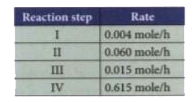Complete Solutions to MANDATORY EXERCISE (SET I) of chapter REACTION KINETICS AND CHEMICAL EQUILIBRIUM of Class 10 book with complete answers and questions
| Class 10 | CHEMISTRY |
| Chapter | REACTION KINETICS AND CHEMICAL EQUILIBRIUM |
| CENGAGE CHEMISTRY | MANDATORY EXERCISE (SET I) |
| Number Of Questions | 23 |
| Academic Year | 2023-24 |
How would you distinguish between reactants and products.
View Solution(a) What do you mean by rate of reaction? How is it expressed mathematically?
(b) Write the rate expression for the following reaction in terms of reactants and products, applying law of mass action.
`2SO_(2)+O_(2)hArr2SO_(3)`
View SolutionDiscuss the effect of concentration and temperature on the rate of reaction.
View SolutionWhich of the following influence the rate of reaction?
View SolutionFor the reaction `2NO+O_(2)to2NO_(2)`, `"rate"=k[NO]^(2)[O_(2)]`. When the volume of the reaction vessel is doubled then the rate will be
View SolutionFor the reaction `2A+BtoC+D` which is of second order with respect to A, the active mass of B is kept constant and that of A is tripled. The rate of reaction
View SolutionA catalyst affects the equilibrium state by
View SolutionMolar concentration of 96 g of `O_(2)` (in mol `L^(-1)`) contained in 2-L vessel is
View SolutionWhich of the following is true statement?
View SolutionIn which case burning of coal take place at faster rate.
View SolutionIf reaction `xtoy` starts with x only then which of the curve represent y (product)
View SolutionIf reaction `x+yhArrz+w` starts with x, y, z and w but net reaction proceeds in backward direction then which of the curve represent variation of concentration of z.

View SolutionFor the reaction `A_(2)(g)+B_(2)(g)to2AB(g)`
If reacting molecule have sufficient energy to cross energy barrier. i.e. reactant can converted into product. Then which collision yield maximum rate of reaction.
View SolutionFor differential rate law
`(+2dA)/(dt)=(-1)/(3)(dB)/(dt)=(+1)/(4)(dC)/(dt)=(-1)/(2)(dD)/(dt)`
Chemical reaction would be
View SolutionFor the energy profile diagram

Threshold energy will be
View SolutionFor the energy profile diagram

Heat of reaction will be
View Solutionn the synthesis of ammonia by Haber process, if 60 moles of ammonia is obtained in one hour, then the rate of disappearance of nitrogen is
View SolutionFor the reaction `Cl_(2)+2I^(Theta)toI_(2)+2Cl^(Theta)` the initial concentration of `I^(-)` was 0.20 mole `L^(-1)` and the concentration after 20 min was 0.18 mole `L^(-1)`. Then the rate of formation of `I_(2)` in mole `L^(-1)"min"^(-1)` would be
View SolutionThe reaction `2SO_(2)(g)+O_(2)(g)hArr2SO_(3)(g)` is carried out in a 1 `dm^(3)` vessel and 2 `dm^(3)` vessel separately. The ratio of the reaction velocities will be
View SolutionFor a reaction between gaseous compounds.`2A+BtoC+D`. The reaction rate = K[A][B]. If the volume of the container is made 1/4 of the initial, then what will be the rate of reaction as compared to the initial rate?
View SolutionFor a reaction between A and B, the initial rate of reaction is measured for various initial concentrations of A and B. The data provided are

The overall order of the reaction is
View SolutionGiven the hypothetical reaction mechanism `Aoverset(I)(to)Boverset(II)(to)Coverset(III)(to)Doverset(IV)(to)E` and the rate as

Rate determining step is
View SolutionA reaction involving A, B and C as reactants is found to obey the rate law,
`"rate"=K[A]^(x)[B]^(y)[C]^(z)`. When the concentrations of A, B and C are doubled separately, the rate is also found to increases two zero and four respectively. The overall order of the reaction is
View Solution
MANDATORY EXERCISE (SET I) questions and complete solutions for chapter REACTION KINETICS AND CHEMICAL EQUILIBRIUM of CENGAGE CHEMISTRY of Class 10